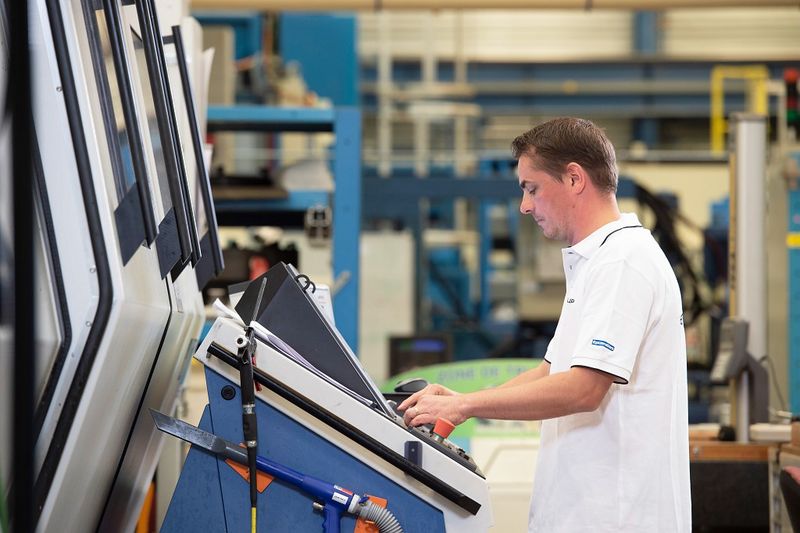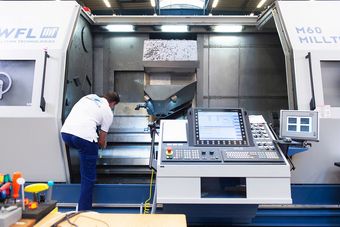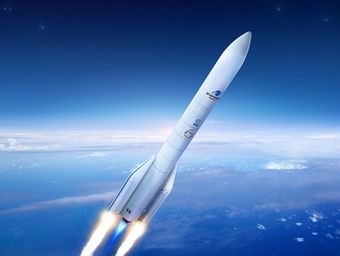
WFL Millturn Technologies Inc.'s multifunction turning and milling centers are employed across various industries, with aerospace being a significant market.
One such user is ArianeGroup, at the forefront of space transportation. The company stands as a prime example of utilizing Millturn machines, and the production of key components necessitates the use of reliable and precise machinery, the company said.
The ArianeGroup site in Vernon, France, designs, develops, manufactures, and tests liquid hydrogen propulsion systems. Much of its activity revolves around propulsion for launch vehicles. The site encompasses three test benches for cryotechnic thrusters and component testing benches. In total, six WFL machines are present on the site: four M60 Millturn and two M35 Millturn, all utilized for machining key components.

Technology at the heart of production
"Machines from WFL are particularly crucial for us as we use them to manufacture high-value parts," stated Delor. The first M60 Millturn was acquired 20 years ago. Since then, three M60s and two M35s have been added to the production hall. Key components or "critical parts" produced on WFL machines are primarily rotating engine parts.
"We primarily require precision and good rigidity in our machines because we machine hard materials that will undergo significant stress during use. Furthermore, process standardization is part of ArianeGroup's business strategy." In production, this entails working with the same machines and the same numerical control. For Delor, this is undeniable: "It saves us time and allows all our operators to work on these machines."
"Our satisfaction has increased as we gained experience with these machines. We have realized that they are good, sturdy, and reliable machines. Therefore, if we were to need a new machine, we would undoubtedly opt for a Millturn. Our colleagues in Ottobrunn, Germany, are also convinced by the Millturn. After visiting our production site in Vernon and the subsequent purchase of an M80, they were able to significantly reduce their production time," adds Dominique Delor.

Understanding customer needs
The Vernon site has been working with WFL machines for 20 years. Dominique Delor asserts, "For 20 years, we have maintained excellent relationships with WFL. Whether your interlocutor is from sales or customer service, competence and trust are present at 100%. WFL understands the customer's needs. For us, in a new project, it is always important to have assurance of a functioning production. And that's the case with WFL. Their service doesn't stop at simply selling a machine. Implementation is also impeccable. By purchasing a WFL machine, we know everything will go smoothly."
"Another reason we are very satisfied with WFL machines is the efficiency of their after-sales service. Our M60 machines are used in three shifts. We produce complex parts and always have to ensure quality and adherence to delivery deadlines. WFL's after-sales service is extremely competent and fast. When we need spare parts, we receive them promptly, and everything works perfectly."
Maintaining performance
ArianeGroup produces a considerable number of parts each year, maintaining a constant and significant activity on the machines. Any rejects are therefore excluded; each piece must be perfect and meet very precise specifications. Quality is an absolute priority in our workshops," Delor emphasized.
"With WFL, we can guarantee this quality. Indeed, one of the great advantages of these machines is adherence to tolerances. Currently, we manually control tolerances, but in the future, we would like to implement automated control. This should contribute, on the one hand, to reducing production time, and on the other hand, to cost savings. We want to utilize machine data and information to plan production in advance through predictive maintenance."
Growing demand
Due to the constantly increasing demand, the technical requirements imposed on launch vehicles are also rising. Delor sees the improvement and digitization of production as a decisive project for the years to come. "I am convinced that with WFL, we will also be able to upgrade our production in terms of monitoring and predictive maintenance."
Contact Details
Related Glossary Terms
- centers
centers
Cone-shaped pins that support a workpiece by one or two ends during machining. The centers fit into holes drilled in the workpiece ends. Centers that turn with the workpiece are called “live” centers; those that do not are called “dead” centers.
- gang cutting ( milling)
gang cutting ( milling)
Machining with several cutters mounted on a single arbor, generally for simultaneous cutting.
- milling
milling
Machining operation in which metal or other material is removed by applying power to a rotating cutter. In vertical milling, the cutting tool is mounted vertically on the spindle. In horizontal milling, the cutting tool is mounted horizontally, either directly on the spindle or on an arbor. Horizontal milling is further broken down into conventional milling, where the cutter rotates opposite the direction of feed, or “up” into the workpiece; and climb milling, where the cutter rotates in the direction of feed, or “down” into the workpiece. Milling operations include plane or surface milling, endmilling, facemilling, angle milling, form milling and profiling.
- numerical control ( NC)
numerical control ( NC)
Any controlled equipment that allows an operator to program its movement by entering a series of coded numbers and symbols. See CNC, computer numerical control; DNC, direct numerical control.
- turning
turning
Workpiece is held in a chuck, mounted on a face plate or secured between centers and rotated while a cutting tool, normally a single-point tool, is fed into it along its periphery or across its end or face. Takes the form of straight turning (cutting along the periphery of the workpiece); taper turning (creating a taper); step turning (turning different-size diameters on the same work); chamfering (beveling an edge or shoulder); facing (cutting on an end); turning threads (usually external but can be internal); roughing (high-volume metal removal); and finishing (final light cuts). Performed on lathes, turning centers, chucking machines, automatic screw machines and similar machines.






